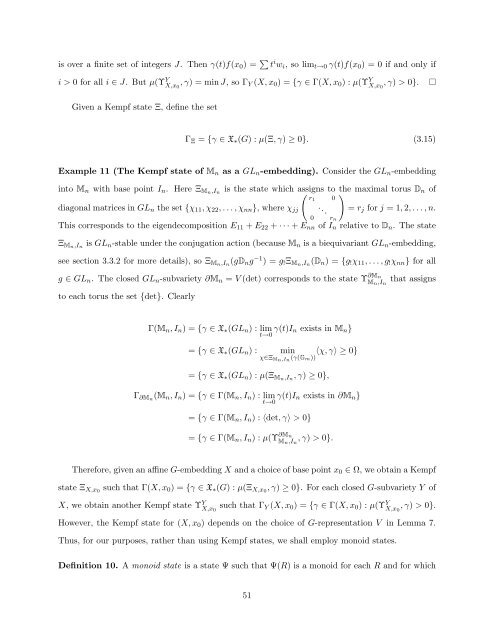Equivariant Embeddings of Algebraic Groups
Equivariant Embeddings of Algebraic Groups
Equivariant Embeddings of Algebraic Groups
Create successful ePaper yourself
Turn your PDF publications into a flip-book with our unique Google optimized e-Paper software.
is over a finite set <strong>of</strong> integers J. Then γ(t)f(x 0 ) = ∑ t i w i , so lim t→0 γ(t)f(x 0 ) = 0 if and only if<br />
i > 0 for all i ∈ J. But µ(Υ Y X,x 0<br />
, γ) = min J, so Γ Y (X, x 0 ) = {γ ∈ Γ(X, x 0 ) : µ(Υ Y X,x 0<br />
, γ) > 0}.<br />
Given a Kempf state Ξ, define the set<br />
Γ Ξ = {γ ∈ X ∗ (G) : µ(Ξ, γ) ≥ 0}. (3.15)<br />
Example 11 (The Kempf state <strong>of</strong> M n as a GL n -embedding). Consider the GL n -embedding<br />
into M n with base point I n . Here Ξ Mn,In<br />
is the state which assigns<br />
(<br />
to the maximal torus D n <strong>of</strong><br />
r1 0<br />
diagonal matrices in GL n the set {χ 11 , χ 22 , . . . , χ nn }, where χ jj<br />
. .. = r j for j = 1, 2, . . . , n.<br />
0 r n<br />
)<br />
This corresponds to the eigendecomposition E 11 + E 22 + · · · + E nn <strong>of</strong> I n relative to D n . The state<br />
Ξ Mn,I n<br />
is GL n -stable under the conjugation action (because M n is a biequivariant GL n -embedding,<br />
see section 3.3.2 for more details), so Ξ Mn,I n<br />
(gD n g −1 ) = g ! Ξ Mn,I n<br />
(D n ) = {g ! χ 11 , . . . , g ! χ nn } for all<br />
g ∈ GL n . The closed GL n -subvariety ∂M n = V (det) corresponds to the state Υ ∂Mn<br />
M n,I n<br />
to each torus the set {det}. Clearly<br />
that assigns<br />
Γ(M n , I n ) = {γ ∈ X ∗ (GL n ) : lim<br />
t→0<br />
γ(t)I n exists in M n }<br />
= {γ ∈ X ∗ (GL n ) : min 〈χ, γ〉 ≥ 0}<br />
χ∈Ξ Mn,In (γ(G m))<br />
= {γ ∈ X ∗ (GL n ) : µ(Ξ Mn,I n<br />
, γ) ≥ 0},<br />
Γ ∂Mn (M n , I n ) = {γ ∈ Γ(M n , I n ) : lim<br />
t→0<br />
γ(t)I n exists in ∂M n }<br />
= {γ ∈ Γ(M n , I n ) : 〈det, γ〉 > 0}<br />
= {γ ∈ Γ(M n , I n ) : µ(Υ ∂Mn<br />
M n,I n<br />
, γ) > 0}.<br />
Therefore, given an affine G-embedding X and a choice <strong>of</strong> base point x 0 ∈ Ω, we obtain a Kempf<br />
state Ξ X,x0 such that Γ(X, x 0 ) = {γ ∈ X ∗ (G) : µ(Ξ X,x0 , γ) ≥ 0}. For each closed G-subvariety Y <strong>of</strong><br />
X, we obtain another Kempf state Υ Y X,x 0<br />
such that Γ Y (X, x 0 ) = {γ ∈ Γ(X, x 0 ) : µ(Υ Y X,x 0<br />
, γ) > 0}.<br />
However, the Kempf state for (X, x 0 ) depends on the choice <strong>of</strong> G-representation V in Lemma 7.<br />
Thus, for our purposes, rather than using Kempf states, we shall employ monoid states.<br />
Definition 10. A monoid state is a state Ψ such that Ψ(R) is a monoid for each R and for which<br />
51
















